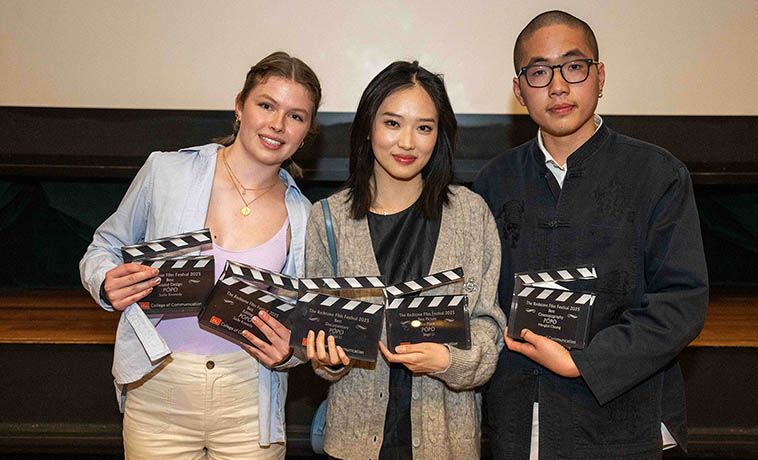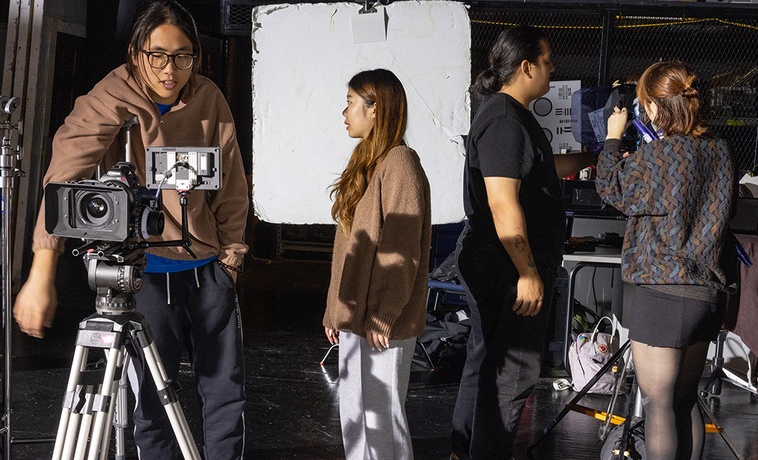
Photo by German Hernandez. Other photos courtesy Carlos Bardasano.
Señor Televisión
Veteran producer and alum Carlos Bardasano is at the nexus of big changes coming to Spanish-language television.
Speaking on Zoom from his office in Miami, television producer Carlos Bardasano shares his screen with me and clicks “play” on a trailer from his newest series, Travesuras de la Niña Mala. Like Nobel Prize winner Mario Vargas Llosa’s 2006 novel by the same name (The Bad Girl in the English version), the drama follows Ricardo Somocurcio’s decades-long obsession with the shadowy and enigmatic Lily he first encounters in Lima in the 1950s. The minute-long clip—a romantic dreamscape shot on location in France—shows the couple reuniting in 1960s Paris, and the scenes feel plucked directly from that time period. Aerial footage showcases the city’s historic architecture at sunset. Dressed as if they’d stepped out of a midcentury French fashion catalog, the lead characters stroll through crowded plazas and past the Eiffel Tower, and dine in outdoor cafés. Antique cars roll by in the background.
“It’s a very ambitious show,” says Bardasano (Questrom’94, COM’97), president and head of content at W Studios, which produces original programs for Spanish-language media and content giant TelevisaUnivision. “It’s probably one of the most expensive shows ever shot in the Spanish language.”
How expensive? “It’s a multimillion-dollar series,” is all he can tell me. Pulling together a pricey, sprawling drama like Travesuras is a departure for Bardasano. Over his 25-year career, he has produced hundreds of episodes of primetime broadcast television—still the preferred medium for most viewers in Latin America. These have mainly been in the popular genre known as telenovelas, although Bardasano has worked on a few sitcoms and dramatic series, and even produced the Billboard Latin Music Awards show. Travesuras, Bardasano’s first exclusively streaming show, will be one of the top draws on TelevisaUnivision’s shiny new ViX+ platform, which launched in July 2022. It’s also his grandest project to date—portraying four distinct decades across a handful of global cities. W Studios tapped Alejandro Bazzano, who directed the Spanish-language crime series Money Heist, which is among the top five most-viewed shows on Netflix, to direct the show.
“We have done period pieces, and we had to do things where we had to travel to different countries. But having to do both?” Bardasano says. “It’s tough, and we wanted to up the level on this.”
When you see something like Grey’s Anatomy, it’s using the same elements that the novela uses, that come from Shakespeare, and Shakespeare took them from the Bible. It’s all about the heart.”
—Carlos Bardasano
The average TV watcher in Medellín or Mexico City may not recognize his name because he’s always behind the scenes. But now, as the world’s largest Spanish-language media company prepares to enter the streaming wars, Bardasano—who serves on the Dean’s Advisory Board at COM—holds immense sway over the stories being told to close to 600 million Spanish-speakers around the globe.
EPISODE 1: LOVE AT FIRST SCREEN
As a child in Caracas, Venezuela, Bardasano was never far from the allure of television and entertainment. Working for the country’s main broadcast network, his father produced commercials for companies like Pepsi. “I don’t remember not being on a set since I was very little,” Bardasano says.

At home, Spanish-language network Televisa—then and now the world’s largest—was often on in the evenings. (The Mexico-based network and the US media company Univision announced their $4.8 billion merger in April 2021 and closed it in January 2022.) American series like The Love Boat, The A-Team and Cheers were also frequently on. Bardasano looked forward to the family’s summer trips to the US so he could catch Johnny Carson and David Letterman, which weren’t shown in Venezuela. One of his most vivid childhood TV-watching memories was of seeing a name pop up over and over at the end of some of his favorite shows: legendary producer Aaron Spelling, who created more than 200 series over his 50-year career, including Charlie’s Angels, Dynasty and Beverly Hills 90210. Bardasano imagined his own name there, at the top of the credits. “Television has been my passion since I can remember,” he says.
Bardasano followed that passion to BU, where he entered Questrom School of Business to study the business side of entertainment. He turned some initial anxiety about the language barrier into motivation to listen more carefully in his undergraduate business classes. Throughout his undergraduate studies, he took summer internships with media and entertainment companies like Disney and kept his eye on his dream of eventually producing great television shows. After searching the country for a graduate program that would combine media and management, he landed across Comm Ave at COM, where he enrolled in the master’s program in film and television management. He credits the international community at BU with “opening my mind and my eyes” to a world in which Spanish-language television could be a career.

He didn’t start out there, however. His first job was at Universal Studios, working on NBC sitcoms of the late 1990s, like Something So Right and Fired Up. Then he moved into executive and supervisory positions at Paramount Pictures and Sony Pictures Television, respectively. His Spanish-language production work ramped up when he joined Telemundo in 2000 as its vice president of programming, responsible for all primetime programming and production. Over the next two decades, Bardasano would earn producer, executive producer and writer credits on some of the most consequential Latin American shows of the modern era—including telenovelas like La Piloto, which he developed, and Amar a Muerte, one of the most-watched telenovelas of 2018.
EPISODE 2: TELENOVELAS…AND BEYOND
Bardasano smirks as he tells me his favorite definition of a telenovela: “two protagonists—a guy and a girl—trying to kiss each other, and a writer not letting them.”
Sometimes confused with soap operas, telenovelas differ in a few ways, he says. Telenovelas tell a finite story with a beginning and an end, even if it takes 200 episodes to do so. Soaps, on the other hand, “go on for generations,” he says. Telenovelas also tend to air during primetime and are watched on broadcast TV rather than streamed. In fact, he says, as much as 90 percent of Spanish-language television is watched when it airs.
When Amar a Muerte (Love to Death)—for which Bardasano served as executive producer—premiered in Mexico in 2018, for instance, 3.8 million households were tuning in. Just over 1.5 million households watched the show’s US premier. The show, which aired 88 episodes over a single season, won 14 TVyNovelas Awards in 2019, including Best Telenovela of the Year.
The genre has found its way into general market American programming. Network shows like Ugly Betty and Jane the Virgin draw from the telenovela formula—albeit with fewer yachts and wind machine–blown hair. Jane, which ran for five seasons, integrates many of the genre’s well-known tropes—characters coming back from the dead and secret identity reveals—throughout the plot. And the telenovela’s storytelling elements of love, treason and revenge also play prominently in the themes of other shows, Bardasano says, such as Shonda Rhimes’ Grey’s Anatomy and Bridgerton.

“When you see something like Grey’s Anatomy, it’s using the same elements that the novela uses, that come from Shakespeare, and Shakespeare took them from the Bible,” he says. “It’s all about the heart.”
Telenovelas, the only purely Latin American TV genre, are still “part of the central structure of any network” aimed at a Spanish-speaking audience and not going away anytime soon, Bardasano says. But the creation of streaming platforms and series like Travesuras de la Niña Mala is an acknowledgement of shifting demographics and media consumption habits across the Spanish speaking world. This is especially true among the more than 62 million Hispanic people in the US, who possess “humongous purchasing power,” Bardasano says. Creating streaming content has become an even bigger priority since Televisa and Univision merged. W Studios is playing an outsized role in that.
“It’s not an or but an and,” Bardasano says, referring to the addition of streaming series to his portfolio. However, he says “with the creation of new platforms like ViX and ViX+, we have the opportunity to do the things that we never before have been able to dream, just because of the budgets that these new platforms are making available to us.” A streaming platform, Bardasano says, also gives him the opportunity to present content that pushes the envelope beyond what he’s traditionally made for more family-oriented network television.
Whether he’s immersed in the romance-fueled hijinks of a telenovela or a period drama like Travesuras, Bardasano says he relishes the chance to tell stories that, he hopes, transport viewers to Paris in the ’60s, a yacht in the Caribbean, or any number of fantastic destinations.


